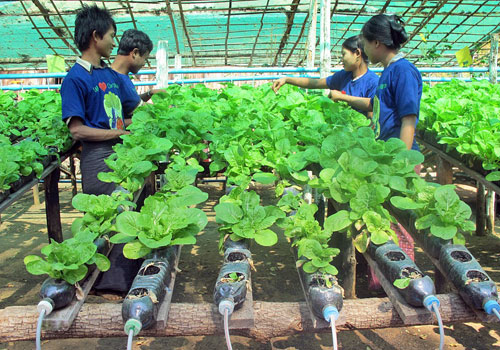 Growing vegetables in tanks and recycled plastic bottles could be the answer to the problems of cultivation in the Myanmar’s dry zone. With the help of an Italian foundation, farmers in Magwe Region can now enjoy the fruits and vegetables even in the dry season.
Growing vegetables in tanks and recycled plastic bottles could be the answer to the problems of cultivation in the Myanmar’s dry zone. With the help of an Italian foundation, farmers in Magwe Region can now enjoy the fruits and vegetables even in the dry season.
The agricultural technique, known as hydroponics, involves growing plants in small tanks, or even in plastic water bottles. Seven hundred households in six villages in Yenangyaung and four in Natmauk have been using hydroponic techniques to grow vegetables since last January in community greenhouses set up by Fondazione TDH Italia and REAM, a Myanmar NGO.
“In Yenangyaung, the soil is mainly sandy and it’s hard to plant vegetables. Using hydroponic techniques helps improve food security. The villagers save money and can earn more, “she said.
For the past 12 months, Fondazione TDH Italia and REAM, a Myanmar NGO, have been running a project in the townships of Yenangyaung and Natmauk. The aim is to improve food security and promote the livelihoods of the most vulnerable groups in an area that suffers from topsoil erosion.
The program is funded by the Italian government, and the University of Bologna, Italy, has also provided assistance.
“Vulnerable villages can grow fresh green vegetables only in the rainy season, so the rest of the year they are short of vitamins and other micro-nutrients like iron. That’s why we introduced sustainable agricultural practices,” said Daw Khin Khin Aye, the assistant project manager at TDH Italia.
TDH has also taught these techniques to farmers and students at Yezin University’s Magwe campus, where a demonstration farm was set up to test the techniques introduced and disseminate them through students and professors.
“This technique can reduce water use, while helping protect plants from pests. It involves recycled materials and avoids waste of nutrients/fertilisers,” said Dr Mi Mi Aung of Yezin University.
TDH built 11,000-gallon rainwater harvester tanks to collect and store water for use in the greenhouses.
“We’ve never planted vegetables like this before. The first time we heard of this technique was last August. In our village, there are 15 villagers who use it. I have cultivated 200 viss of vegetables (one viss equals 1.6 kilograms or 3.6 pounds). Though the project ended in January, we’re still using [the technique],” said villager Sa Khan Can.
Another villager, U Aung Thein, said he had built a small hydroponic greenhouse in his compound after seeing the community greenhouse and had successfully produced lettuce, Chinese kale and mustard.
TDH is discussing possible sources of funding to expand its activities in the dry zone for the next three years and says the greenhouses not only improves the diet of people in the dry zone, but also generate extra income.
Original Link Myanmar Times
